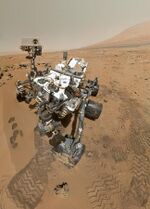Astronomy:2010 WG9
| Discovery[1] | |
|---|---|
| Discovered by | LaSilla–Quest Variability Srvy. |
| Discovery site | La Silla Observatory |
| Discovery date | 30 November 2010 (discovery: first observation only) |
| Designations | |
| 2010 WG9 | |
| Minor planet category | TNO[1] · centaur · distant[2] |
| Orbital characteristics[1] | |
| Epoch 4 September 2017 (JD 2458000.5) | |
| Uncertainty parameter 3 | |
| Observation arc | 6.22 yr (2,271 days) |
| |{{{apsis}}}|helion}} | 87.037 AU |
| |{{{apsis}}}|helion}} | 18.765 AU |
| 52.901 AU | |
| Eccentricity | 0.6453 |
| Orbital period | 384.77 yr (140,538 days) |
| Mean anomaly | 10.821° |
| Mean motion | 0° 0m 9.36s / day |
| Inclination | 70.331° |
| Longitude of ascending node | 92.065° |
| 293.00° | |
| Physical characteristics | |
| Dimensions | 100.81 km (calculated)[3] 112.7±61.9 km[4] |
| Rotation period | 263.8±0.1 h[5] |
| Geometric albedo | 0.074±0.080[4] 0.10 (assumed)[3] |
| B–R = 1.10[6] B–V = 0.798±0.034[5] V–R = 0.520±0.018[5] | |
| Absolute magnitude (H) | 8.1[1][3] |
2010 WG9 is a high inclination trans-Neptunian object and slow rotator from the outer Solar System, approximately 100 kilometers in diameter.[1] It was first observed at ESO's La Silla Observatory in northern Chile on 30 November 2010.[2]
Orbit and classification
2010 WG9 orbits the Sun at a distance of 18.8–87.0 AU once every 384 years and 9 months (140,538 days). Its orbit has an eccentricity of 0.65 and an inclination of 70° with respect to the ecliptic.[1]
As of October 2019, it is one of six known objects with inclination (i) > 60° and perihelion (q) > 15 AU, along with the first discovered 2008 KV42.[7]
Physical characteristics
Rotation period
A rotational lightcurve of 2010 WG9 was obtained from photometric observations by the LaSilla–Quest Variability Survey at La Silla in Chile. Lightcurve analysis gave a rotation period of 263.8 hours with a brightness amplitude of 0.14 magnitude ({{{1}}}).[5] It belongs to the Top 200 slowest rotators known to exist.
Diameter and albedo
It measures 112.7 kilometers in diameter and its surface has an albedo of 0.074.[4] The Collaborative Asteroid Lightcurve Link assumes a standard albedo of 0.10 and calculates a diameter of 100.81 kilometers based on an absolute magnitude of 8.1.[3]
References
- ↑ Jump up to: 1.0 1.1 1.2 1.3 1.4 1.5 "JPL Small-Body Database Browser: (2010 WG9)". Jet Propulsion Laboratory. http://ssd.jpl.nasa.gov/sbdb.cgi?sstr=3554395. Retrieved 25 July 2017.
- ↑ Jump up to: 2.0 2.1 "2010 WG9". Minor Planet Center. http://www.minorplanetcenter.net/db_search/show_object?object_id=2010+WG9. Retrieved 25 July 2017.
- ↑ Jump up to: 3.0 3.1 3.2 3.3 "LCDB Data for (2010)". Asteroid Lightcurve Database (LCDB). http://www.minorplanet.info/PHP/generateOneAsteroidInfo.php?AstInfo=0%7C2010+WG9. Retrieved 25 July 2017.
- ↑ Jump up to: 4.0 4.1 4.2 Bauer, James M.; Grav, Tommy; Blauvelt, Erin; Mainzer, A. K.; Masiero, Joseph R.; Stevenson, Rachel et al. (August 2013). "Centaurs and Scattered Disk Objects in the Thermal Infrared: Analysis of WISE/NEOWISE Observations". The Astrophysical Journal 773 (1): 11. doi:10.1088/0004-637X/773/1/22. Bibcode: 2013ApJ...773...22B.
- ↑ Jump up to: 5.0 5.1 5.2 5.3 Rabinowitz, David; Schwamb, Megan E.; Hadjiyska, Elena; Tourtellotte, Suzanne; Rojo, Patricio (July 2013). "The Peculiar Photometric Properties of 2010 WG9: A Slowly Rotating Trans-Neptunian Object from the Oort Cloud". The Astronomical Journal 146 (1): 10. doi:10.1088/0004-6256/146/1/17. Bibcode: 2013AJ....146...17R.
- ↑ "List of Known Trans-Neptunian Objects". Johnston's Archive. http://www.johnstonsarchive.net/astro/tnoslist.html. Retrieved 26 July 2017.
- ↑ "Custom query: i = 60 and q = 15+". Minor Planet Center. http://minorplanetcenter.net/db_search/show_by_properties?perihelion_distance_min=15&inclination_min=60. Retrieved 26 July 2017.
External links
- List Of Centaurs and Scattered-Disk Objects, Minor Planet Center
- 2010 WG9 at AstDyS-2, Asteroids—Dynamic Site
- 2010 WG9 at the JPL Small-Body Database
 |



